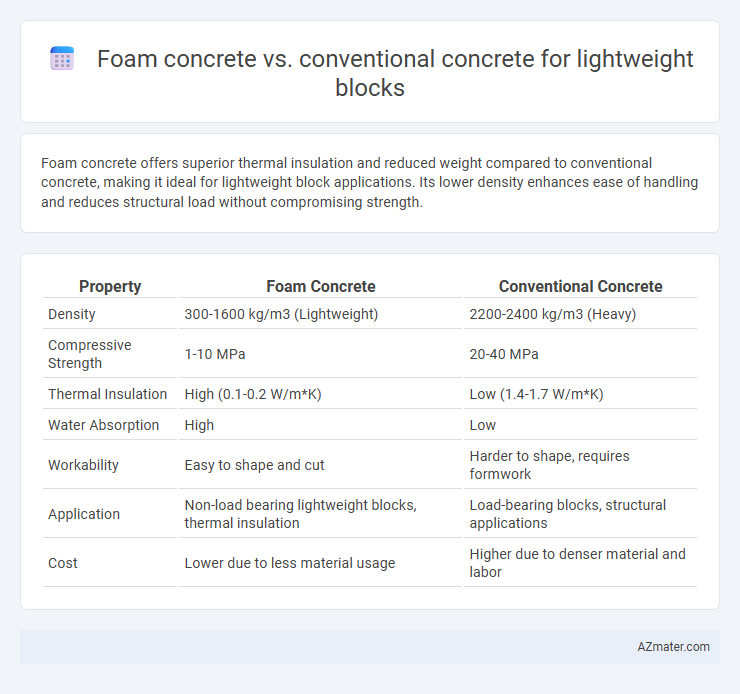Foam concrete offers superior thermal insulation and reduced weight compared to conventional concrete, making it ideal for lightweight block applications. Its lower density enhances ease of handling and reduces structural load without compromising strength.
Table of Comparison
| Property | Foam Concrete | Conventional Concrete |
|---|---|---|
| Density | 300-1600 kg/m3 (Lightweight) | 2200-2400 kg/m3 (Heavy) |
| Compressive Strength | 1-10 MPa | 20-40 MPa |
| Thermal Insulation | High (0.1-0.2 W/m*K) | Low (1.4-1.7 W/m*K) |
| Water Absorption | High | Low |
| Workability | Easy to shape and cut | Harder to shape, requires formwork |
| Application | Non-load bearing lightweight blocks, thermal insulation | Load-bearing blocks, structural applications |
| Cost | Lower due to less material usage | Higher due to denser material and labor |
Introduction to Foam Concrete and Conventional Concrete
Foam concrete is a lightweight, aerated material produced by mixing cement, water, and a stable foam to create a low-density block ideal for insulation and soundproofing. Conventional concrete consists of cement, water, sand, and aggregates, yielding a denser and stronger block commonly used in structural applications. Foam concrete offers enhanced thermal and acoustic performance, whereas conventional concrete provides higher compressive strength for load-bearing requirements.
Composition and Manufacturing Process
Foam concrete is composed of cement, water, fine aggregates, and a pre-formed foam generated by a foaming agent, creating air bubbles that reduce density and improve insulation. Conventional concrete for lightweight blocks typically uses lightweight aggregates such as expanded clay, shale, or pumice, mixed with cement and water, relying on solid particles instead of air voids to reduce weight. Manufacturing foam concrete involves mixing the foam into the cement slurry before casting, while conventional lightweight concrete requires careful mixing of lightweight aggregates to ensure uniformity and strength in the blocks.
Density and Weight Comparison
Foam concrete has a significantly lower density, typically ranging from 400 to 1600 kg/m3, compared to conventional concrete which usually has a density around 2400 kg/m3, making foam concrete much lighter. This reduced density results in lightweight blocks that are easier to handle, transport, and install, leading to faster construction times and reduced labor costs. The lower weight of foam concrete blocks also decreases structural load on foundations, enhancing building efficiency and reducing overall material consumption.
Mechanical Strength and Load-Bearing Capacity
Foam concrete offers significantly lower mechanical strength and load-bearing capacity compared to conventional concrete, making it less suitable for structural applications requiring high compressive strength. Conventional concrete typically achieves compressive strengths ranging from 20 to 40 MPa, whereas foam concrete often exhibits strengths below 10 MPa due to its high air content and porous structure. Lightweight blocks made with foam concrete are advantageous for non-load-bearing walls and insulation purposes, while conventional concrete blocks remain the preferred choice for load-bearing walls and structural components that demand higher durability and strength.
Thermal and Acoustic Insulation Properties
Foam concrete offers superior thermal insulation compared to conventional concrete due to its porous structure, significantly reducing heat transfer in lightweight blocks. Its cellular composition also enhances acoustic insulation by absorbing sound waves, making it ideal for noise-sensitive environments. Conventional concrete, while structurally strong, lacks these insulation properties, resulting in heavier blocks with lower energy efficiency and sound dampening capabilities.
Workability and Application Techniques
Foam concrete offers superior workability compared to conventional concrete due to its lightweight, flowable nature, allowing easy placement and reduced compaction effort in lightweight block production. The application techniques for foam concrete typically involve mixing a pre-formed foam with a cement slurry, enabling consistent density control and excellent insulation properties. Conventional concrete requires mechanical vibration for compaction and has limited flowability, making it less efficient for intricate forms and lightweight block applications.
Cost Analysis and Economic Considerations
Foam concrete offers significant cost savings in lightweight block production due to reduced material usage and lower transportation expenses, as its lower density decreases overall structural weight and foundation requirements. Conventional concrete, while often more expensive initially because of higher cement and aggregate content, typically provides superior compressive strength, which can influence long-term maintenance and durability costs. Economic considerations must balance initial material and labor costs with lifecycle performance, where foam concrete's insulating properties and quicker installation may result in enhanced overall project cost efficiency.
Environmental Impact and Sustainability
Foam concrete significantly reduces environmental impact by utilizing air-entrained voids, leading to lower raw material consumption and decreased carbon dioxide emissions compared to conventional concrete. Its lightweight nature improves thermal insulation, reducing energy demand in buildings and enhancing sustainability efforts. Additionally, foam concrete's ability to incorporate industrial by-products like fly ash further minimizes waste and promotes eco-friendly construction practices.
Durability and Lifespan
Foam concrete offers enhanced durability and a longer lifespan compared to conventional concrete for lightweight blocks due to its improved resistance to freeze-thaw cycles and reduced permeability. The cellular structure of foam concrete provides better insulation and mitigates cracking, contributing to extended structural integrity. Conventional concrete, while strong, is more susceptible to moisture penetration and deterioration under harsh environmental conditions, resulting in a comparatively shorter lifespan.
Best Use Cases: Choosing Between Foam and Conventional Concrete Blocks
Foam concrete excels in insulation and soundproofing, making it ideal for non-load bearing walls and partition blocks in residential and commercial buildings. Conventional concrete blocks provide superior compressive strength, suitable for structural applications such as load-bearing walls and foundations. Selecting between foam and conventional concrete blocks depends on balancing thermal performance requirements and structural strength needs for specific construction projects.

Infographic: Foam concrete vs Conventional concrete for Lightweight block
 azmater.com
azmater.com